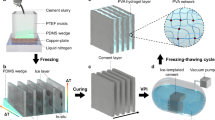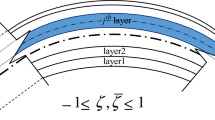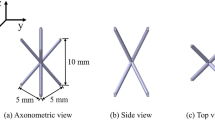Abstract
Thin shells are widely used in structural design and developing lightweight high-performance materials and composites. A fluid coating-assisted additive manufacturing method proposed in the literature shows great potential in fabricating lightweight composites using shell-like framework architectures. However, understanding the fabrication of thin shells by controlling the fluid rheology for a submillimeter-thin coating is still limited. As a demonstration, we investigated the effect of surface tension and yield stress of cement paste on the spreading and stabilisation on a curved honeycomb scaffold to form a thin-shell structure via a lattice-Boltzmann method simulation. We found the coating of cement paste is governed by the coupling effect of surface tension (γ) and yield stress (σy), which not only controls the stability but also affects its geometry. The optimal ranges of γ and σy were determined and their correlation was derived as a design guideline for future development of this cementitious thin-shell structure. As well, equivalent microscale rheological parameters (γ = 0.015 N/m and σy = 3.42 Pa) were identified. This study improves our understanding of the fabrication of high-performance cementitious shells and sheds light on the fabrication of submillimetre-thin shells using a wide range of materials.













Similar content being viewed by others
References
Tomlinson M, Tomlinson A, Li Chapman M, Jefferson A, Wright H (1990) Shell composite construction for shallow draft immersed tube tunnels, in Immersed tunnel techniques. Thomas Telford Publishing, London, pp 209–220
Kostopoulos V, Markopoulos Y, Giannopoulos G, Vlachos D (2002) Finite element analysis of impact damage response of composite motorcycle safety helmets. Compos B Eng 33:99–107
Bonatti C, Mohr D (2019) Smooth-shell metamaterials of cubic symmetry: anisotropic elasticity, yield strength and specific energy absorption. Acta Mater 164:301–321
Han SC, Lee JW, Kang K (2015) A new type of low density material: Shellular. Adv Mater 27:5506–5511
Nguyen BD, Cho JS, Kang K (2016) Optimal design of “Shellular”, a micro-architectured material with ultralow density. Mater Des 95:490–500
Bauer J, Hengsbach S, Tesari I, Schwaiger R, Kraft O (2014) High-strength cellular ceramic composites with 3D microarchitecture. Proc Natl Acad Sci 111:2453–2458
Han SC, Choi JM, Liu G, Kang K (2017) A microscopic shell structure with Schwarz’s D-surface. Sci Rep 7:1–8
Mohammed MI, Badwal PS, Gibson I (2017) Design and fabrication considerations for three dimensional scaffold structures. KnE Eng 2:120–126
Sakovsky M, Ermanni P (2020) A thin-shell shape adaptable composite metamaterial. Compos Struct 246:112390
Martin TP, Layman CN, Moore KM, Orris GJ (2012) Elastic shells with high-contrast material properties as acoustic metamaterial components. Phys Rev B 85:161103
Titovich AS, Norris AN (2014) Tunable cylindrical shell as an element in acoustic metamaterial. J Acoust Soc Am 136:1601–1609
Ngo TD, Kashani A, Imbalzano G, Nguyen KT, Hui D (2018) Additive manufacturing (3D printing): a review of materials, methods, applications and challenges. Compos B Eng 143:172–196
Muth JT, Dixon PG, Woish L, Gibson LJ, Lewis JA (2017) Architected cellular ceramics with tailored stiffness via direct foam writing. Proc Natl Acad Sci 114:1832–1837
Compton BG, Lewis JA (2014) 3D-printing of lightweight cellular composites. Adv Mater 26:5930–5935
Voisin HP, Gordeyeva K, Siqueira G, Hausmann MK, Studart AR, Bergström L (2018) 3D printing of strong lightweight cellular structures using polysaccharide-based composite foams. ACS Sustain Chem Eng 6:17160–17167
Frazier WE (2014) Metal additive manufacturing: a review. J Mater Eng Perform 23:1917–1928
Parandoush P, Lin D (2017) A review on additive manufacturing of polymer-fiber composites. Compos Struct 182:36–53
Balla VK, Kate KH, Satyavolu J, Singh P, Tadimeti JGD (2019) Additive manufacturing of natural fiber reinforced polymer composites: processing and prospects. Compos Part B Eng 174:1956
Chen Z, Li Z, Li J, Liu C, Lao C, Fu Y, Liu C, Li Y, Wang P, He Y (2019) 3D printing of ceramics: a review. J Eur Ceram Soc 39:661–687
Duan WH, Chen SJ, Wang W (2017) Light weight concrete. WO 2017/152238 Al
Ragelle H, Tibbitt MW, Wu S-Y, Castillo MA, Cheng GZ, Gangadharan SP, Anderson DG, Cima MJ, Langer R (2018) Surface tension-assisted additive manufacturing. Nat Commun 9:1184
Lim S, Buswell R, Le T, Wackrow R, Austin SA, Gibb A, Thorpe T (2011) Development of a viable concrete printing process. In: Proceedings of the 28th International Symposium on Automation and Robotics in Construction, Seoul, pp 665–670
Murphy SV, Atala A (2014) 3D bioprinting of tissues and organs. Nat Biotechnol 32:773–785
Zhang J, Kwok DY (2013) Lattice Boltzmann method (LBM). In: Li D (ed) Encyclopedia of microfluidics and nanofluidics. Springer, Boston, pp 1–8
Mohamad A (2011) Lattice Boltzmann method, vol 70. Springer, Berlin
Kefayati GHR, Huilgol RR (2017) Lattice Boltzmann method for the simulation of the steady flow of a Bingham fluid in a pipe of square cross-section. Eur J Mech B Fluids 65:412–422. https://doi.org/10.1016/j.euromechflu.2017.02.001
Zou L, Håkansson U, Cvetkovic V (2020) Analysis of Bingham fluid radial flow in smooth fractures. J Rock Mech Geotech Eng 12:1112–1118. https://doi.org/10.1016/j.jrmge.2019.12.021
Anderson JD, Wendt J (1995) Computational fluid dynamics, vol 206. Springer, Berlin
Fan Z, Zhao Y, Kaufman A, He Y (2005) Adapted unstructured LBM for flow simulation on curved surfaces. In: Proceedings of the 2005 ACM SIGGRAPH/Eurographics symposium on computer animation, Los Angeles, pp 245–254
Yan Y, Zu Y (2008) Numerical simulation of heat transfer and fluid flow past a rotating isothermal cylinder–a LBM approach. Int J Heat Mass Transfer 51:2519–2536
Martys NS, Chen H (1996) Simulation of multicomponent fluids in complex three-dimensional geometries by the lattice Boltzmann method. Phys Rev E 53:743–750. https://doi.org/10.1103/PhysRevE.53.743
He X, Chen S, Zhang R (1999) A lattice Boltzmann scheme for incompressible multiphase flow and its application in simulation of Rayleigh-Taylor instability. J Comput Phys 152:642–663
Murata J (1984) Flow and deformation of fresh concrete. Mater Construct 17:117–129
Morinaga S (1973) Pumpability of concrete and pumping pressure in pipelines. In: Proceedings of Rilem seminar, Leeds, pp 7.3–1 to 7.3–39
Tattersall G (1976) Relationships between the British Standard tests for workability and the two-point test. Mag Concr Res 28:143–147
AS 3972 (2010) General purpose and blended cements. Standards Association of Australia, Sydney
Collins F, Lambert J, Duan WH (2012) The influences of admixtures on the dispersion, workability, and strength of carbon nanotube–OPC paste mixtures. Cement Concr Compos 34:201–207
Zou B, Chen SJ, Korayem AH, Collins F, Wang C, Duan WH (2015) Effect of ultrasonication energy on engineering properties of carbon nanotube reinforced cement pastes. Carbon 85:212–220
ASTM C1738/C1738M-14 (2014) Standard practice for high-shear mixing of hydraulic cement pastes. American Society for Testing and Materials (ASTM) International, West Conshohocken, PA
Dong B, Yan YY, Li WZ (2011) LBM simulation of viscous fingering phenomenon in immiscible displacement of two fluids in porous media. Transp Porous Media 88:293–314. https://doi.org/10.1007/s11242-011-9740-y
Anderl D, Bogner S, Rauh C, Rüde U, Delgado A (2014) Free surface lattice Boltzmann with enhanced bubble model. Comput Math Appl 67:331–339. https://doi.org/10.1016/j.camwa.2013.06.007
Perumal DA, Dass AK (2015) A Review on the development of lattice Boltzmann computation of macro fluid flows and heat transfer. Alex Eng J 54:955–971. https://doi.org/10.1016/j.aej.2015.07.015
Jeyaraj JA (2018) Numerical modeling of concrete flow in drilled shaft. Dissertation, University of South Florida
Bouvet A, Ghorbel E, Bennacer R (2010) The mini-conical slump flow test: analysis and numerical study. Cem Concr Res 40:1517–1523
Rehman KU, Alshomrani AS, Malik MY (2018) Carreau fluid flow in a thermally stratified medium with heat generation/absorption effects. Case Stud Therm Eng 12:16–25. https://doi.org/10.1016/j.csite.2018.03.001
Valigi MC, Logozzo S, Rinchi M (2016) Wear resistance of blades in planetary concrete mixers. Design of a new improved blade shape and 2D validation. Tribol Int 96:191–201. https://doi.org/10.1016/j.triboint.2015.12.020
Carreau PJ (1972) Rheological equations from molecular network theories. Trans Soc Rheol 16:99–127. https://doi.org/10.1122/1.549276
Filippova O, Hänel D (1998) Grid refinement for lattice-BGK models. J Comput Phys 147:219–228
Ferraris CF, Obla KH, Hill R (2001) The influence of mineral admixtures on the rheology of cement paste and concrete. Cem Concr Res 31:245–255. https://doi.org/10.1016/S0008-8846(00)00454-3
Nehdi M, Rahman MA (2004) Estimating rheological properties of cement pastes using various rheological models for different test geometry, gap and surface friction. Cem Concr Res 34:1993–2007. https://doi.org/10.1016/j.cemconres.2004.02.020
Tregger N, Ferrara L, Shah SP (2008) Identifying viscosity of cement paste from mini-slump-flow test. ACI Mater J 105:558
Kwon O, Krishnamoorthy M, Cho YI, Sankovic JM, Banerjee RK (2008) Effect of blood viscosity on oxygen transport in residual stenosed artery following angioplasty. J Biomech Eng 130:011003
Kwack J, Masud A (2014) A stabilized mixed finite element method for shear-rate dependent non-Newtonian fluids: 3D benchmark problems and application to blood flow in bifurcating arteries. Comput Mech 53:751–776
Marcovich NE, Reboredo MM, Kenny J, Aranguren MI (2004) Rheology of particle suspensions in viscoelastic media. Wood flour-polypropylene melt. Rheol Acta 43:293–303
Tesfaye M, Patwa R, Dhar P, Katiyar V (2017) Nanosilk-grafted poly (lactic acid) films: influence of cross-linking on rheology and thermal stability. ACS Omega 2:7071–7084
Lachemi M, Hossain KMA, Lambros V, Nkinamubanzi PC, Bouzoubaâ N (2004) Performance of new viscosity modifying admixtures in enhancing the rheological properties of cement paste. Cem Concr Res 34:185–193. https://doi.org/10.1016/S0008-8846(03)00233-3
Roussel N, Stefani C, Leroy R (2005) From mini-cone test to Abrams cone test: measurement of cement-based materials yield stress using slump tests. Cem Concr Res 35:817–822. https://doi.org/10.1016/j.cemconres.2004.07.032
Vargaftik N, Volkov B, Voljak L (1983) International tables of the surface tension of water. J Phys Chem Ref Data 12:817–820
Lura P, Jensen OM, Van Breugel K (2003) Autogenous shrinkage in high-performance cement paste: an evaluation of basic mechanisms. Cem Concr Res 33:223–232
Jensen OM (1993) Autogenous deformation and RH-change—self-desiccation and self-desiccation shrinkage. Build Mater Lab Tech Univ Den Lyngby Den 285:93
Chopard B, Lagrava D, Malaspinas O, Ouared R, Latt J, Lovblad KO, Pereira V (2010) A lattice Boltzmann modeling of bloodflow in cerebral aneurysms. In: V European Conference on Computational Fluid Dynamics, Lisbon, 453:12
Rapp BE (2016) Microfluidics: modeling, mechanics and mathematics. William Andrew: Norwich, NY, USA. https://doi.org/10.1016/B978-1-4557-3141-1.50038-1
Zhang X, Han J (2000) The effect of ultra-fine admixture on the rheological property of cement paste. Cem Concr Res 30:827–830. https://doi.org/10.1016/S0008-8846(00)00236-2
Sonmez FO (2009) Optimal shape design of shoulder fillets for flat and round bars under various loadings. Proc Inst Mech Eng C J Mech Eng Sci 223:1741–1754. https://doi.org/10.1243/09544062JMES1457
Leyer A (2012) Machine design. Springer, Netherlands
Han D, Ferron RD (2015) Effect of mixing method on microstructure and rheology of cement paste. Constr Build Mater 93:278–288
Lunkenheimer K, Wantke K-D (1981) Determination of the surface tension of surfactant solutions applying the method of Lecomte du Noüy (ring tensiometer). Colloid Polym Sci 259:354–366
Bentz DP, Garboczi EJ, Haecker CJ, Jensen OM (1999) Effects of cement particle size distribution on performance properties of Portland cement-based materials. Cem Concr Res 29:1663–1671
Bentz DP, Jensen OM, Hansen KK, Olesen JF, Stang H, Haecker CJ (2001) Influence of cement particle-size distribution on early age autogenous strains and stresses in cement-based materials. J Am Ceram Soc 84:129–135
Cepuritis R, Jacobsen S, Smeplass S, Mørtsell E, Wigum BJ, Ng S (2017) Influence of crushed aggregate fines with micro-proportioned particle size distributions on rheology of cement paste. Cem Concr Compos 80:64–79
Marek C (1995) Importance of fine aggregate shape and grading on properties of concrete. Proceedings of the international center for aggregates research 3rd annual symposium, Austin, TX, USA pp 1–4
Lomboy G (2012) Particle interaction and rheological behavior of cement-based materials at micro-and macro-scales. Dissertation, Iowa State University. https://doi.org/10.31274/etd-180810-1838
Acknowledgements
The authors are grateful for the financial support of the Australian Research Council (IH150100006) in conducting this study. Dr Shujian Chen is the recipient of an Australian Research Council Discovery Early Career Award (DE170100604) funded by the Australian Government. The authors acknowledge the use of facilities within the Monash Centre for Electron Microscopy. This work was performed in part at the Melbourne Centre for Nanofabrication (MCN) in the Victorian Node of the Australian National Fabrication Facility (ANFF).
Author information
Authors and Affiliations
Contributions
WW, SJC and WD conceived the study and designed the simulation. WW, SJC and BG conducted the simulation. WW analysed the data and wrote the manuscript. SJC, JZL, WD and KS-C assisted in evaluating the results, writing the discussion, and editing the manuscript.
Corresponding authors
Ethics declarations
Competing interests
The authors declare no competing interests.
Additional information
Publisher's Note
Springer Nature remains neutral with regard to jurisdictional claims in published maps and institutional affiliations.
Rights and permissions
About this article
Cite this article
Wang, W., Gerber, B., Lai, J.Z. et al. Controlling the rheological properties of cement for a submillimetre-thin shell structure. Mater Struct 54, 141 (2021). https://doi.org/10.1617/s11527-021-01735-5
Received:
Accepted:
Published:
DOI: https://doi.org/10.1617/s11527-021-01735-5




